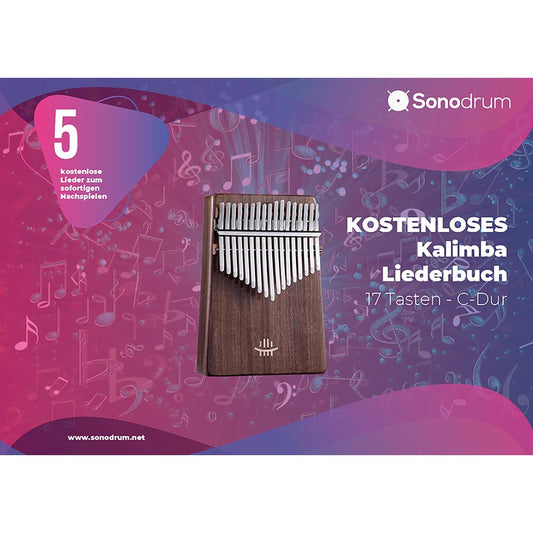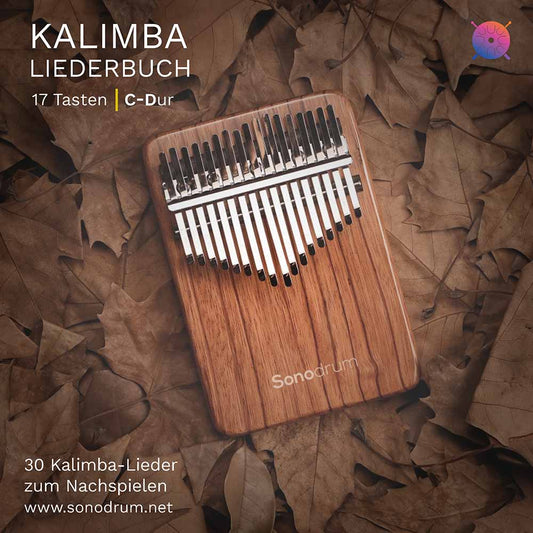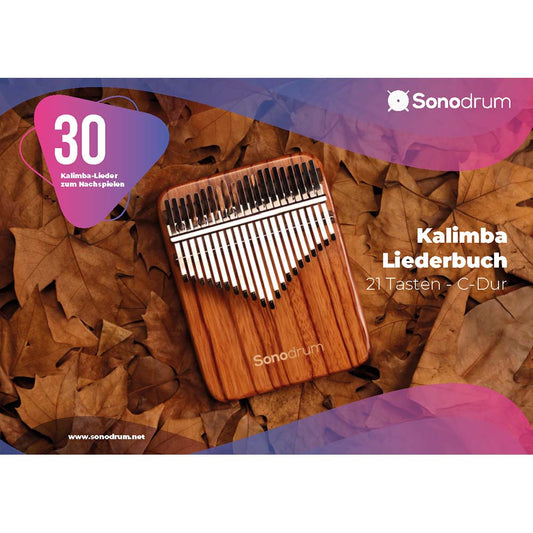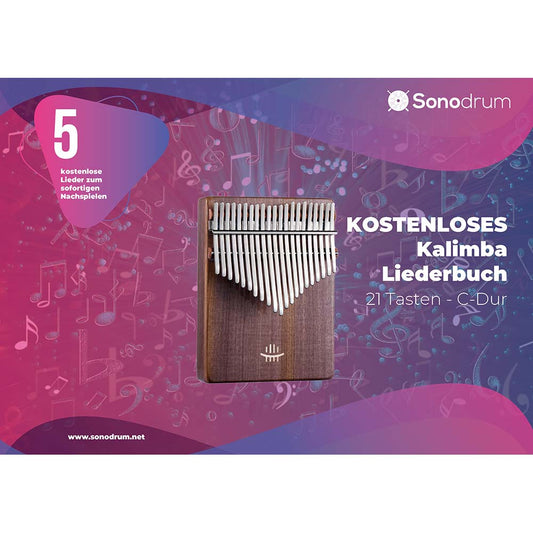Collection: Kalimba notes
-
Free Kalimba Songbook - 17 Keys - C Major - PDF for Download
Regular price 0 krRegular priceUnit price / per111 krSale price 0 krSale -
Kalimba Songbook - 17 keys - C major - 30 songs - PDF for download
Regular price 111 krRegular priceUnit price / per167 krSale price 111 krSale -
Kalimba Songbook - 21 keys - C major - 30 songs - PDF for download
Regular price 111 krRegular priceUnit price / per167 krSale price 111 krSale -
Free Kalimba Songbook - 21 keys - C major - PDF for download
Regular price 0 krRegular priceUnit price / per111 krSale price 0 krSale -
Kalimba Musikbuch - 50 Relaxing Songs - Für alle Kalimbas in C-Dur mit 17 / 21 Tasten - PDF zum Download
Regular price 145 krRegular priceUnit price / per167 krSale price 145 krSale -
Kalimba Musikbuch - 50 Deutsche Weihnachtslieder - Für alle Kalimbas in C-Dur mit 17 / 21 Tasten - PDF zum Download
Regular price 145 krRegular priceUnit price / per167 krSale price 145 krSale -
Kalimba Musikbuch - 50 Classic Songs - Für alle Kalimbas in C-Dur mit 17 / 21 Tasten - PDF zum Download
Regular price 145 krRegular priceUnit price / per167 krSale price 145 krSale -
Kalimba Musikbuch - 50 Deutsche Kinderlieder - Für alle Kalimbas in C-Dur mit 17 / 21 Tasten - PDF zum Download
Regular price 145 krRegular priceUnit price / per167 krSale price 145 krSale
The Kalimba is not a widely known instrument and if you ask around, many people don't know what you're talking about. And there are still some misconceptions about how it works and what the numbers stand for. We want to help you find out everything about the Kalimba and have a surprise for you: Kalimba Sheet Music - Free Kalimba Sheet Music PDF to Print .
If you're thinking of getting a kalimba and wondering if it's hard to play and how it works, then this article is for you. It's one of the easiest instruments for a beginner to play. Anyone with a touch of musicality can understand how a well-tuned kalimba works and play a few simple tunes in a few minutes, without a manual, teacher or YouTube tutorial. But it's still better if you have our free printable sheet music at hand.
Playing it well... well, that takes a little longer, but don't worry, we're not talking decades. Here's a quick introduction to the instrument: The numbers on a kalimba indicate the degrees of the major scale it is tuned to. Most kalimbas are tuned to C, and so the numbers from 1 to 7 indicate the degrees of the C major scale , so C | D | E | F | G | A | B, and these correspond to 1 | 2 | 3 | 4 | 5 | 6 | 7.
Now you know roughly what it is about, but you will learn a lot more here. Read on and have fun with Kalimba notes .
WHAT IS A KALIMBA
The Kalimba, or thumb piano as it is also called, is a musical instrument that you definitely shouldn't miss out on! It is probably one of the most uncomplicated instruments for beginners and professionals alike and is becoming increasingly popular!
The kalimba is a hand-held instrument with metal tines/keys that are plucked to produce sounds. The body is often made of wood, but other variants are also popular, such as acrylic.
When plucked, the kalimba keys produce a clear, bright, almost percussive sound. The instrument is often tuned to C major, which gives it a very pleasant sound quality .

WHAT ARE KALIMBA NOTES?
A customer recently wrote to us:
"I have a lot of trouble playing my kalimba. I took piano lessons for three years as a child and I think that's the problem. Is there a tip that will help me read the kalimba notes better than the piano notes?"
The kalimba and the piano are very different instruments!
Two major differences are that the kalimba has only a small subset of the notes that the piano has, and that the kalimba notes are arranged in a way that is fundamentally different from the arrangement on the piano.
While the general introduction to music you received in piano lessons will be helpful on your journey to the kalimba, the specific muscle memory (and the way you think about reading and playing music) you developed while playing the piano is pretty much irrelevant to playing the kalimba sheet music . But don't worry, sheet music for kalimba is our topic and we'll explain how it works and how you can get kalimba sheet music for free !
Diatonic Kalimbas
Not every kalimba is a diatonic kalimba, but most kalimbas found today are diatonic kalimbas. "Diatonic" is a fancy word that means the kalimba only has the notes of a major scale - you know, "Do Re Mi Fa So La Ti Do." It can have one octave, two octaves, or more, but it must have all of those notes, and it will not have any other notes. There are five places where other notes (basses and sharps) fall between those notes - between "Do" and "Re," for example. These are the "black notes" of the piano, and they are absent on a diatonic kalimba.
Speaking of which, an easy way to think of diatonic kalimbas is that they have only the white notes of the piano - C, D, E, F, G, A, B, C - but no black notes like F#/ Gb (the small "b" stands for a B) or C#/ Db. A kalimba that has all the notes, both the white and black, is called a chromatic kalimba .
The limited range of the Kalimba
Another obvious difference between piano and kalimba notes is the range, i.e. the distance between the lowest and highest notes. Not only does the kalimba scale lack several notes between the kalimba notes it plays , but the notes for kalimba don't go very low or very high. A typical 17-note kalimba in C ranges from C4 to E6, while the 88-note piano ranges from A0 to C8 (The numbers represent the octave on the piano. A0 is the lowest note. C4 is middle C, and there are 8 octaves). The kalimba's limited range becomes a problem because some melodies don't fit well on the kalimba, and if you're trying to arrange ordinary piano music (i.e. melody and accompaniment with lower notes), you'll need to make some adjustments on the kalimba - for example, the piano's left-hand notes may need to be transposed up an octave or two or otherwise altered to fit the kalimba notes .
Alternating note layout
The most significant difference between the kalimba and the piano, however, is the way the notes are arranged . The piano has a linear arrangement of notes. The low notes are on the left and the high notes are on the right. There is no ambiguity. This is completely logical. When you want to play the piano, your brain internalizes this structure - a direct correlation between pitch and position on the piano keyboard. Moreover, there is a very clear and simple relationship between the notes in the linear staff notation and the linear arrangement of notes on the piano.
But the kalimba has a bilinear note arrangement. The low kalimba notes are in the middle, while the higher kalimba notes are on the far left AND the far right. If you play three notes next to each other on one side, you get something like: 1 - 3 - 5, or 2 - 4 - 6, or 3 - 5 - 7. These are all beautiful chords. In other words, the recipe for how to arrange the notes for kalimba is pretty much the same as the recipe for diatonic chords.
One thing is certain and we will be mentioning it here more often. If you are starting to play the Kalimba, then you should get the Kalimba sheet music PDF from us for free. Enter your email address on our website and we will immediately send you the Kalimba sheet music PDF by email , which you can use to experiment a lot at home. The sheet music with notes to print out for free will be a great help to you!

LEARNING KALIMBA NOTES – A FEASIBLE GOAL WITH LOTS OF MUSICAL FUN
If you have just ordered the Kalimba from us, you will first have to pluck it around a bit to get a feel for the instrument and the Kalimba notes .
To play a scale on the kalimba, you have to jump back and forth in a zigzag pattern. Most tunes contain sections of the scale, which means you have to play the scale well. In some ways, the scale is one of the more difficult things on the kalimba because you jump from the right side to the left side and back to the right side. On the low notes in the middle of the kalimba, this is relatively easy because you don't have to jump very far. However, the higher you go on the kalimba, the bigger and more error-prone each jump from one side to the other becomes. But it is also quite simple.
Tip: When going up or down the scale, don't think about jumping from a key on the left to a key on the right. Instead, remember where each of your thumbs last played a key. The next key the left thumb plays will be one key further than the one it last played.
Before you search for free sheet music online , you should remember the key of your Kalimba - or which notes your Kalimba has . Most 17-tone Kalimbas are tuned in C major. This means that the notes C, D, E, F, G, A and B form the key of the instrument. We have designed a very special free Kalimba sheet music PDF for you that matches the Kalimbas we sell.
How does kalimba tablature relate to staff notation?
The short answer is: Staff notation directly shows the pitch, which is simply related to the linear arrangement of the notes on the piano. Kalimba tablature directly shows the keys on your kalimba that you need to pluck to play the song.
The key of your kalimba is not fixed - you can change it by retuning it. For example, if you retune the kalimba so that the F notes become F sharp (F#), i.e. half a tone higher, the key of the kalimba changes to G major.
KALIMBA SHEET MUSIC FOR FREE - HERE YOU CAN PRINT YOUR KALIMBA SHEET MUSIC PDF!
The new Kalimba sheet music PDF that we offer at Sonodrum will immediately put you on the right path. Playing a Kalimba has never been so easy. The Kalimba sheet music and songs match the instrument, which you can buy online at Sonodrum.
Since the notes your kalimba can play at any given time are always limited, you need to make sure the kalimba notes you are looking for are available in the key of your kalimba unless you are willing to retune it. For this reason, some players who play kalimba frequently buy extra kalimbas to save themselves the trouble of retuning. You can't go far wrong with the beginner kalimba notes , this is about playing complex kalimba songs/ kalimba note songs .
The sheet music with notes that you can print out for free from us is particularly suitable for beginners. Don't worry about music theory at first, just follow the Kalimba notes and the labels on the keys and you'll quickly have a song together. Important! Just because a song isn't in the natural key of C doesn't mean that you can't play it on the Kalimba. Notes can be transposed into the key of C and still sound easily recognizable.
This is because it is the intervals between the notes that we recognize as a melody, not the actual notes themselves. Don't worry if you don't understand what this means. Just know that you can play most of the songs you want to play on the kalimba without much difficulty - and the free kalimba sheet music will definitely help.
INSTRUCTIONS FOR KALIMBA NOTES
The Kalimba is a musical instrument like any other. It requires a certain level of mastery to play it. In addition to technique, musical knowledge is also required. Sometimes a good musical ear is enough. You can find Kalimba notes online or request a free Kalimba sheet music PDF from us.
The structure of a Kalimba
A traditional instrument from Africa, the kalimba is a lamellophone. As such, it consists of keys or lamellae . These vibrate on a crossbeam or bridge, or directly on a sound box. The lamellae are also called keys or tines. Originally, they were made of bamboo. They still exist today, but most models have keys made of metal. They have different lengths and therefore different pitches . The longest has the lowest note and is placed in the middle. In contrast, the highest note is at the end and is played by the shortest key. The sound box is usually made of wood with a cavity drilled into it.
Fine-tuning
Before you play any instrument, you need to make sure it is tuned correctly. The Kalimba is no exception. Whether it is a newly purchased instrument or a material that has not been used for a while, the tuning must be checked. If you order a Kalimba from Sonodrum , no matter how many keys it has, you will receive it in the perfect fine tuning and can start playing the first beginner Kalimba notes right away. Free sheet music online is available everywhere, but it is not specifically tuned to the Sonodrum. So be sure to request the Kalimba sheet music songs that you can get for free.
A poorly tuned instrument not only affects the ears, but also reduces the lifespan of the kalimba. Tuning is part of the care of the instrument. It is usually tuned to a pentatonic scale. This consists of five notes. So in the C major scale, the notes of the kalimba are C, D, E, G, A. Whether the kalimba has 5, 7 or 9 notes, it will contain these kalimba notes .
How to play the Kalimba
The kalimba is held with two hands. You can hold it in front of your chest or on your knees, whichever you find most comfortable. This comfort can refer to the posture or the sound. The sound is a little more muted if you hold the instrument on your knees, while you will feel more comfortable sitting down. The kalimba is played with two thumbs, but some professional musicians also use the index finger. The sound is produced by stroking the tip of the lamella with the tip of the fingernail to make it vibrate.
You can play the Kalimba notes as an ascending scale faster and faster. Then learn the descending scale. Then you can play both alternately. Once you are used to the sound of the keys, start learning melodies. Take the beginner Kalimba notes from the PDF. Once you are familiar with music theory, you can follow a score.
There are numerous tutorials and free sheet music online on the Internet . These are a valuable aid to playing the Kalimba correctly. Use everything you have at your disposal as best you can to master this instrument. And you can find many free Kalimba sheet music at Sonodrum without having to search for long!
How to amplify the sound of a kalimba
The kalimba is an idiophone, meaning it produces its own sounds. This means that it can be heard well when you play in a small circle. Since the sound box is quite small, the volume is not very strong. However, it is possible to amplify the notes you play on the kalimba . Traditionally, this instrument is amplified using an additional sound box. A calabash or a drum are usually good for this. In the first case, the kalimba is placed inside. In the second case, the instrument is placed on the skin. To create a metallic vibrato effect, bottle caps can be placed on the sound box.
LEARN TO PLAY KALIMBA - NOTES FOR KALIMBA IN OUR FREE PDF
Go to the Sonodrum website and to the Kalimbas. There you will see a button that you can use to order Kalimba sheet music songs free of charge as a PDF , which we will then send to you by email. All you need to do is enter your email address and that's it. You will receive the sheet music with notes to print out free of charge within a few minutes.
Kalimba sheet music songs - the most famous Kalimba songs in sheet music
The most well-known song that you can easily play with our Kalimba sheet music templates is “ Happy Birthday to you ”! But we will briefly introduce you to others here that you can easily play. There is a huge number of sheet music available online for free and in our Kalimba sheet music PDF !
happy Birthday to you
This is a birthday greeting song. Although it is over a hundred years old, it is still one of the most famous and most sung songs in the world. It was only made available to the public in 2015 when the copyright expired. Now it can be offered everywhere. It sounds especially beautiful on the 21-key kalimba . You will fall in love with these kalimba notes !
Kalimba sheet music free: To Joy
Another song that everyone immediately recognizes is “Ode to Joy” by Ludwig van Beethoven, which was written to the poem by Friedrich Schiller. You probably know it and the kalimba notes sound particularly cheerful when the song is sung.
Kalimba Sheet Music: We Wish You A Merry Christmas
Another piece of music that really needs no introduction, but is so popular that it just had to be included in our Kalimba sheet music PDF . It sounds unique when you play it on a 17-key kalimba. This is a traditional English Christmas carol that dates back to the 16th century.
Kalimba Notes: Twinkle, Twinkle, Little Star
You can play this song with 10 keys. It sounds beautiful when plucked on the kalimba and it is not difficult to play. Just try it with these kalimba notes . The author, Jane Taylor (1783-1824), first published this text in 1806 in a collection of children's poems, Nursery Rhymes. It is based on the French folk song "Ah! vous dirai-je, Maman", a folk song that was first recorded in 1761 and is better known in German-speaking countries through the Christmas carol "Morgen kommt der Weihnachtsmann".
CATEGORIES OF KALIMBA NOTES
The more reeds/keys a kalimba has, the more complicated it might be to play. The good thing is that there is something for every taste and level of musician.
10 Tongue Kalimba
Many of our customers are very fond of the 10-key kalimba. We believe it is one of the best choices for most children between the ages of 8 and 14. But we also believe that there are many adults who buy a 17-note kalimba and then get frustrated because it is more complicated than they imagine.
17 Tongue Kalimba
The best place to start is to figure out how many keys you want on your kalimba. You will find that many kalimbas on the market and also at Sonodrum have 17 keys and are tuned to a specific key (standard tuning in the key of C). The most important thing to remember is that with more keys/ kalimba notes you can play more chords .
Most of the free sheet music online is for 17-tongue kalimbas. You will also find many songs for this type of kalimba in our beginner kalimba sheet music book.
21 Tongue Kalimba
What many people may not consider is the spacing between the reeds/keys on the kalimba. If you have larger fingers, playing a closely spaced kalimba can be challenging. This is especially important if your playing style requires precise plucking. Precision is very important when playing a thumb piano, so be sure to consider what type of spacing works best for your fingers. There is no doubt that this instrument will allow you to play more kalimba notes and therefore play a wider range of songs.
The sheet music for beginners, Kalimba sheet music to play songs correctly!
With music books for beginners and the Kalimba sheet music song books, which we can offer free of charge as a PDF, it is easy to play Kalimba sheet music correctly right away. We recommend that you request the PDF and try it. You will definitely not be disappointed and you will be amazed at how you can suddenly play complete songs on the Kalimba.
KALIMBA NOTES CONCLUSION
We hope you can now decide on your Kalimba and will create a sensation with the free Kalimba sheet music that we provide you with. Not only in your home, but also with your audience.
The kalimba is a great portable musical instrument that produces glockenspiel-like tones and is a great first instrument for beginners due to its ease of use and low cost.
We hope that this article has given you some good information about the Kalimba and that you have discovered a fantastic new instrument to add to your collection. Kalimba Sheet Music - free Kalimba Sheet Music PDF to print , don't forget that you can order it from the Sonodrum website and it will save you many hours of experimentation.

FAQS: FREQUENTLY ASKED QUESTIONS ABOUT KALIMBA NOTES
How to read Kalimba notes?
The notes in the PDF correspond to the keys on your kalimba. Start reading from bottom to top. You will quickly figure out how to play a complete song.
How to learn Kalimba notes?
You can memorize the Kalimba notes that correspond to the notes in the PDF. It goes very quickly, because you usually start with 10 or 17 keys. Almost all songs can be played using these Kalimba notes .
Is it difficult to learn Kalimba notes?
It is an instrument that is ideal for people who want to get into music. Kalimba notes are easy to learn and the playback produces a great sound.
Are there free Kalimba sheet music available as PDF online?
Yes, you don't have to look for long because you can order it from us. Go to the Sonodrum page and click on the Kalimba tab. There you will find the button that you can use to order the PDF.
What are Kalimba Notes?
Kalimba notes are the sounds that your Kalimba produces. You can find the Kalimba notes in a PDF that you can order, download and print for free. It is like a music book that converts normal notes into Kalimba notes and allows you to play songs on your Kalimba straight away.








